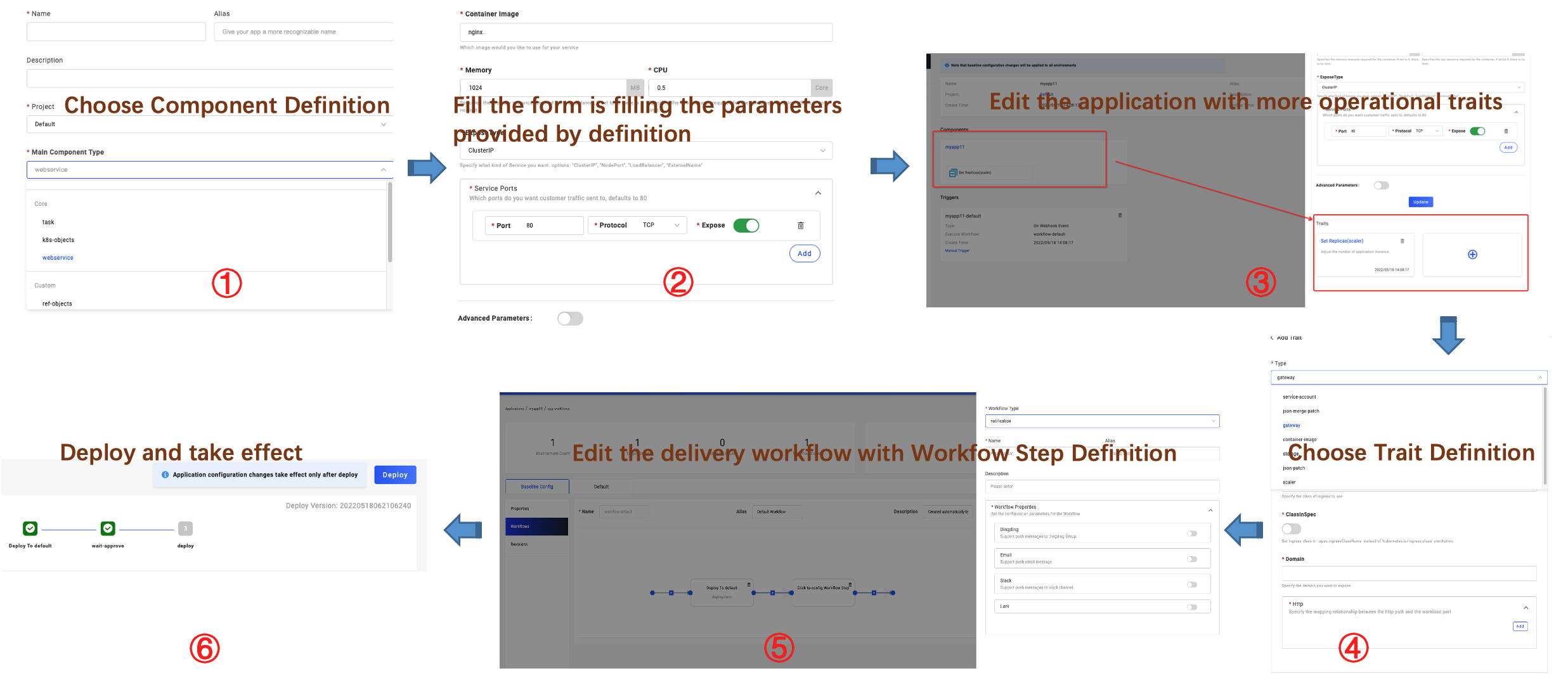模块定义
模块定义是组成 KubeVela 平台的基本扩展能力单元,一个模块定义就像乐高积木,它将底层的能力封装成抽象的模块,使得这些能力可以被最终用户快速理解、使用并和其他能力组装、衔接,最终构成一个具有丰富功能的业务应用。模块定义最大的优势是可以被分发和共享,在不同的业务应用中重复使用,在基于 KubeVela 的不同平台上均能执行。
目前 KubeVela 一共有四种不同类型的模块定义,分别是组件定义(ComponentDefinition)、运维特征定义(TraitDefinition)、策略定义(PolicyDefinition)以及工作流步骤定义(WorkflowStepDefinition),对应了构成应用的四个基本概念。
如何获取现成的模块定义?
除了自己编写模块定义以外,你可以通过以下两大途径获得社区已有的模块定义:
- KubeVela 安装时自动就会安装内置的模块定义,你可以在下面这些参考文档中查看有哪些现成的能力:
- 扩展插件列表,作为 KubeVela 的扩展,每一个插件都包含一组模块定义以及支撑其功能的 CRD Controller。
- 社区有一个插件注册中心包含了大量开箱即用的插件,由 KubeVela 核心维护者负责认证和维护。
模块定义的生命周期
一个模块定义通常有三个生命周期阶段:
发现
当模块定义被安装到 KubeVela 控制平面以后,最终用户就可以立即发现和查看它们。
- 查看模块定义列表
$ vela def list
NAME TYPE NAMESPACE DESCRIPTION
webservice ComponentDefinition vela-system Describes long-running, scalable, containerized services
that have a stable network endpoint to receive external
network traffic from customers.
gateway TraitDefinition vela-system Enable public web traffic for the component, the ingress API
matches K8s v1.20+.
health PolicyDefinition vela-system Apply periodical health checking to the application.
notification WorkflowStepDefinition vela-system Send message to webhook
...snip...
- 查看模块定义的参数
$ vela show webservice
# Properties
+------------------+-------------------------------------------------------------------------------------------+-----------------------------------+----------+---------+
| NAME | DESCRIPTION | TYPE | REQUIRED | DEFAULT |
+------------------+-------------------------------------------------------------------------------------------+-----------------------------------+----------+---------+
| cmd | Commands to run in the container | []string | false | |
| env | Define arguments by using environment variables | [[]env](#env) | false | |
| labels | Specify the labels in the workload | map[string]string | false | |
| annotations | Specify the annotations in the workload | map[string]string | false | |
| image | Which image would you like to use for your service | string | true | |
| ports | Which ports do you want customer traffic sent to, defaults to 80 | [[]ports](#ports) | false | |
+------------------+-------------------------------------------------------------------------------------------+-----------------------------------+----------+---------+
...snip...
你也可以通过命令行打开一个网页查看这些参数:
vela show webservice --web
- 在 KubeVela 的 UI 控制台(需安装 velaux 插件)也可以看到

模块定义在 UI 控制台上可以比较方便的查看,更重要的是会有一个比较好的用户体验,你还可以自定义 UI 展示来优化 UI 控制台上模块定义的参数展示。
使用
在 KubeVela 的 UI 控制台上使用模块定义是非常自然的,整个流程紧紧围绕应用部署计划展开,你只要跟着界面操作指引一步步点击即可使用。

分为如下几步:
- 创建应用选择组件类型,这个过程就是选择使用某个组件定义。
- 填写组件的参数则会根据组件定义的不同出现不同的待填写参数。
- 运维特征、策略、工作流步骤的使用也是如此,分别在不同的应用部署计划业务流程中体现。
最终 UI 控制台会组装成一个符合 OAM 模型定义的完整应用部署计划,然后 KubeVela 控制器会自动化处理剩下的事情:
apiVersion: core.oam.dev/v1beta1
kind: Application
metadata:
name: first-vela-app
spec:
components:
- name: express-server
type: webservice
properties:
image: oamdev/hello-world
ports:
- port: 8000
expose: true
traits:
- type: scaler
properties:
replicas: 1
policies:
- name: target-default
type: topology
properties:
clusters: ["local"]
namespace: "default"
- name: target-prod
type: topology
properties:
clusters: ["local"]
namespace: "prod"
- name: deploy-ha
type: override
properties:
components:
- type: webservice
traits:
- type: scaler
properties:
replicas: 2
workflow:
steps:
- name: deploy2default
type: deploy
properties:
policies: ["target-default"]
- name: manual-approval
type: suspend
- name: deploy2prod
type: deploy
properties:
policies: ["target-prod", "deploy-ha"]
使用 KubeVela 命令行工具来使用模块定义也是如此,只要编写上述 Application 对象的 YAML 文件即可,可以使用 vela 命令如下:
vela up -f https://kubevela.net/example/applications/first-app.yaml
Application 也是一种 Kubernetes 的 CRD,你可以通过 kubectl 工具,或者直接调用 Kubernetes API 集成 KubeVela 功能。
自定义
⚠️ 请注意,在多数情况下,你不需要编写自定义模块,除非你的目的是扩展 KubeVela 的系统能力。在此之前,我们建议你先查看 KubeVela 内置的模块定义以及扩展插件,可能它们已经足够满足你的需求。
KubeVela 使用 CUE 配置语言来编写自定义模块,如果你对 CUE 语言还不熟悉也不必担心,可以查看 CUE 入门指南,花 15 分钟即可了解基本的实用操作。
一个模块定义包含输入、输出、操作以及这三者之间的衔接关系,一个简单的组件模块定义如下所示:
webserver: {
type: "component"
attributes: {}
}
template: {
parameter: {
name: string
image: string
}
output: {
apiVersion: "apps/v1"
kind: "Deployment"
spec: {
containers: [{
name: parameter.name
image: parameter.image
}]
}
}
}
type 字段定义了这个模块是哪种类型(组件、运维特征、策略或者工作流步骤), parameter 定义了模块的输入,output 定义了模块的输出。还有一些高级的操作你可以通过了解如何管理、编写模块定义以及模块定义与 Kubernetes 的交互协议 等章节文档了解更多细节。
下一步
- 查看 KubeVela 项目架构文档了解全局的架构。